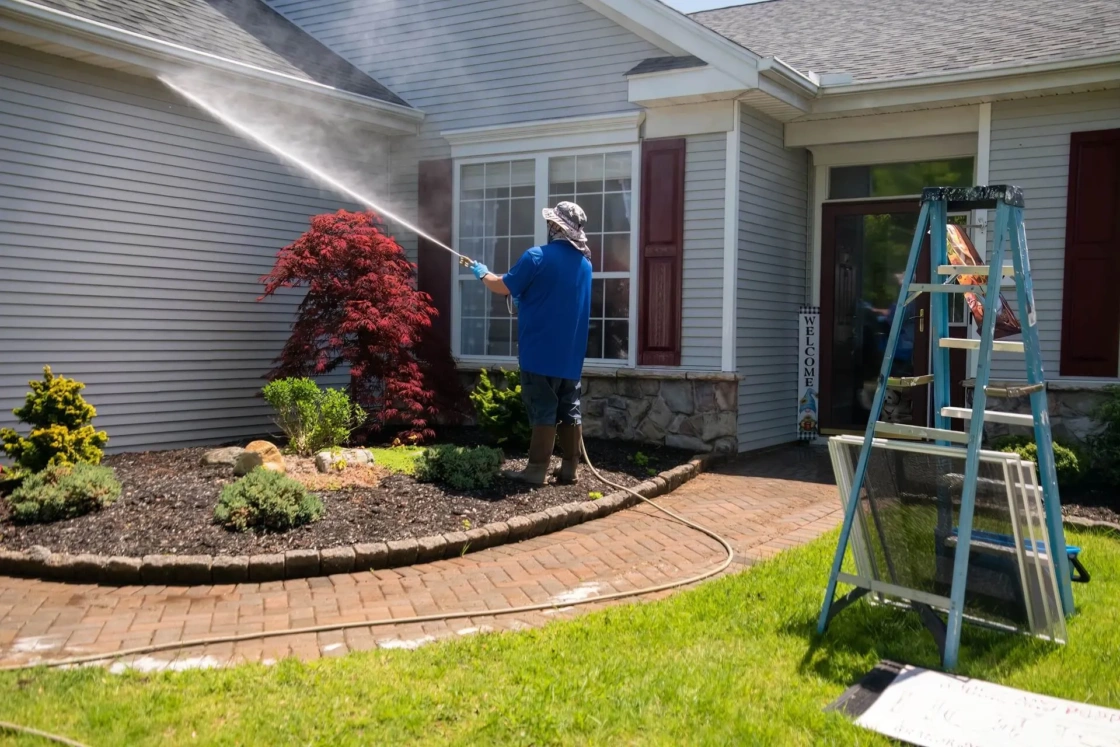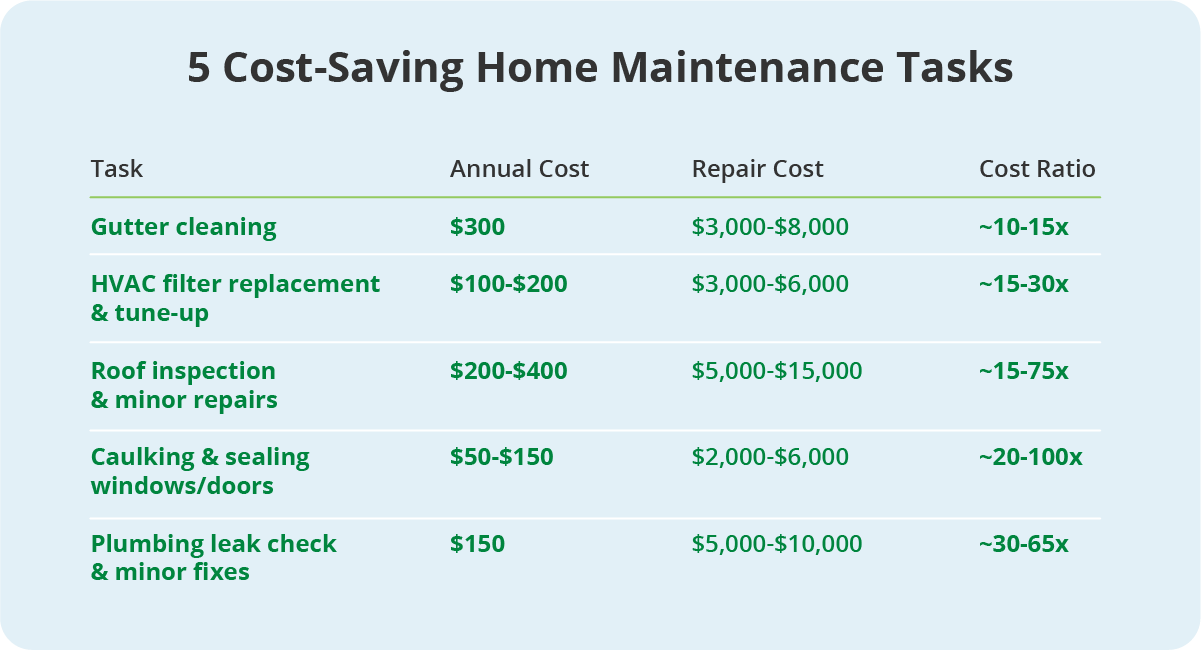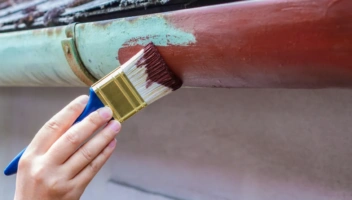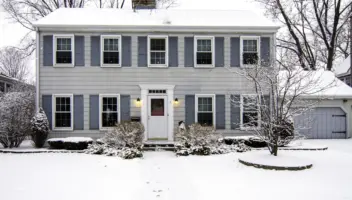Stop Damage Before It Starts: The 5 Most Important Home Maintenance Jobs

Homeownership is rewarding, but even small maintenance jobs you put off today can snowball into five-figure repair bills tomorrow. Picture a thunderstorm where clogged gutters spill water behind your siding, or an icy roof where one loose shingle lets meltwater drip into the attic. Add a furnace straining against a clogged filter, and you have three preventable disasters lining up to drain your bank account.
This report shows prevention is always the cheaper option. Routine upkeep, including simple measures like a gutter protection system from LeafFilter, helps keep normal wear-and-tear from growing into expensive problems. LeafFilter’s mission is to stop water damage before it starts by helping keep gutters flowing, making it a smart maintenance decision that can head off major headaches.
Our Methodology
For each task below, we compared two price tags:
- Annual cost for routine service or basic DIY supplies.
- Potential repair cost if that task is ignored long enough for something to fail.
All numbers are based on 2025 data published by trusted consumer resources like Forbes, This Old House, HomeAdvisor, Angi, Modernize, in addition to the LeafFilter blog. They represent national averages. Your local market may sit a little higher or lower, but the gap between prevention and repair stays wide almost everywhere. That gap exists because once damage occurs, it escalates with time. A slow drip becomes a stained ceiling, then warped drywall, then mold remediation. Mechanical parts follow the same pattern. A dirty air filter forces your blower motor to overheat; eventually, the entire HVAC system can seize.
Our cost ratio shows how many times more affordable annual maintenance is than the worst-case repair bill. A 10x ratio means it is ten times cheaper to maintain than to repair. Curious about where your home is in our list of expensive cities for home maintenance?
The Five Tasks
The table below makes the savings clear at a glance. Any ratio in double digits should grab your attention; some of these maintenance tasks outweigh the repair costs by 20 to 1. We’ll break down each task individually below the table, along with practical tips on when to schedule the work and what red flags to watch for in between.

Task #1: Gutter Cleaning
How often should you clean out your gutters? Most homes should have gutters cleaned out twice a year, once after spring pollen drops and again after leaves fall in the autumn. Professional gutter cleaning crews average about one hour for a typical single-story house, and the fee usually includes bagging debris and flushing downspouts. Budgeting $300 a year for this service ($150, twice a year) keeps water moving away from your roofline and foundation.
So, what happens if you don’t clean out your gutters? Warning signs that your gutters need attention include overflow during steady rain, dark streaks on siding beneath the eaves, or plants sprouting from the troughs. Leave those clogs in place and water will back up under shingles, roof decking, and behind exterior walls. Repair bills can start to increase drastically once framing and insulation get soaked. The average water damage repair cost is $3,000–$8,000 depending on severity, according to Forbes. That makes cleaning out gutters about 10 to 15 times cheaper than repairing the damage it prevents.
The simplest long-term fix is a permanent gutter guard like LeafFilter’s stainless steel micromesh. It helps prevent leaves and other debris from sitting on top so water flows through, giving homeowners a solution that pays for itself over time. Check out our gutter cleaning guide for lots of handy tips.
Task #2: HVAC Filter Replacement & Tune-Up
Your HVAC system circulates the air you breathe, so a clean filter is both a maintenance and health priority. Swap disposable filters every one to three months depending on pets, allergy concerns, and local dust levels. High-efficiency pleated filters only cost around $20 each.
An annual professional tune-up adds another $100-$200. The technician verifies refrigerant charge, lubricates motors, and tests safety sensors. These small steps reduce strain on expensive components like the compressor or heat exchanger. Ignore them and a full replacement can run five figures once labor and haul-away charges enter the quote. Even before total failure, an overworked system uses more energy, jacking utility bills up month after month. Routine care not only safeguards the equipment but also helps cut down on operating costs in every season. Preventative care here is roughly 15 to 30 times cheaper than replacing the system altogether.
Task #3: Roof Inspection & Minor Repairs
Your roof is your home’s first shield against weather. Unfortunately, storm winds can lift shingles and tree branches can scrape and puncture a roof system. Booking a professional inspection once a year, ideally in late spring or early fall, costs $200-$400, according to HomeAdvisor. Many roofing companies include a small repair allowance in that fee, tightening fasteners or replacing individual shingles while on site.
Between visits, keep an eye on the attic. Look for sunlight peeking through boards, dark stains on rafters, or musty odors after rain. Outside, check for shingles that curl, buckle, or shed granules into gutters. Repairing these minor problems may only require a few replacement shingles and a tube of roofing sealant. Leave them unchecked, and water can infiltrate decking, insulation, and ceiling drywall. A complete tear-off with new underlayment, ventilation upgrades, and interior restoration can cost between $5,000-$15,000. Annual inspections are a modest insurance policy against that expense. That makes inspections and minor fixes roughly 15 to 75 times less expensive than a major roof overhaul.
Task #4: Caulking & Sealing Windows/Doors
Gaps around window and door frames create two problems at once: conditioned air leaks out, and water sneaks in. A single afternoon with a caulking gun and a $20 tube of high-quality exterior sealant can restore a tight seal. If kneeling on a ladder is not in your comfort zone, a handyman or window specialist will usually tackle a whole house for about $150.
Check exterior joints each spring. If the caulk looks brittle, crumbles when pressed, or pulls away from the siding, it has lost its elasticity. Indoors, drafts near trim or unexplained energy spikes on utility bills can also hint at failing seals. Water intrusion is the bigger threat, though. Small leaks can travel inside wall cavities where they stay hidden until paint bubbles or mold appears. Remediation includes removing drywall, treating framing, and replacing insulation or flooring. Those costs add up quickly ($2,000-$6,000) compared with the price of a few tubes of sealant. With that math, sealing up those gaps is roughly 20 to 100 times cheaper than dealing with mold damage later.
Task #5: Plumbing Leak Check & Minor Fixes
Water under pressure is relentless. Over time, pipe joints loosen, valves corrode, and supply lines become brittle. A licensed plumber can walk through a house in under 2 hours for approximately $100-$200, tighten fittings, and swap aging hoses on washing machines or dishwashers.
As the homeowner, you can supplement that yearly check by scanning under sinks and behind toilets once a month. Look for mineral deposits on shut-off valves, staining on cabinet floors, or even tiny insect trails that indicate moisture somewhere it shouldn’t be. Consider installing inexpensive leak detectors that sit on the floor and chirp when they sense moisture.
Catch a drip early and you may just pay for a new valve. Miss it and you could wake up to a burst line that floods multiple rooms. Dry-out fans, mold treatments, and flooring replacement easily push repairs past $5,000-$10,000, not counting the headache of living through weeks of restoration work. That makes a simple plumbing check 30 to 65 times more cost-effective than dealing with flood cleanup.
Prevention Pays Off
Every task above shares one lesson. A house does not fail all at once; it wears down a little each day. Spending a few hundred dollars spread across the year builds a barrier that keeps major damage at bay. Added up, the five jobs cost roughly the price of a long weekend getaway, yet they guard the largest investment most families ever make. Preventative products like LeafFilter gutter protection help make maintenance even easier by converting a repeat cost like gutter cleaning into a one-time installation with a lifetime transferable warranty.
A little care today helps keep your home healthier, safer, and better-protected tomorrow. Add these five tasks to your yearly checklist, set calendar reminders, and enjoy the comfort of knowing you are protecting both your wallet and your home’s long-term value.


